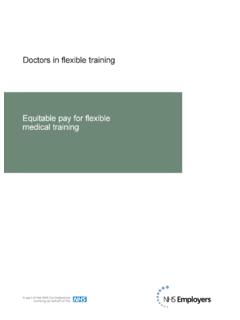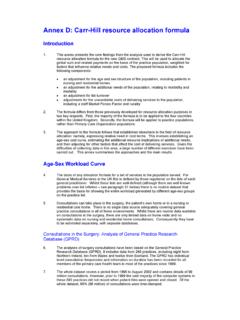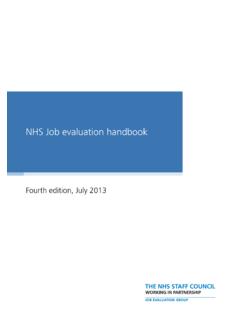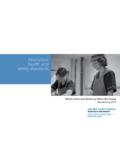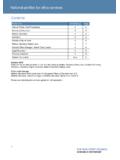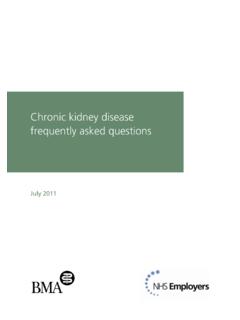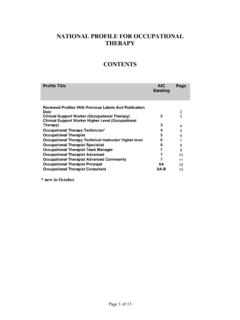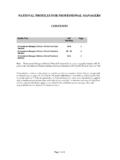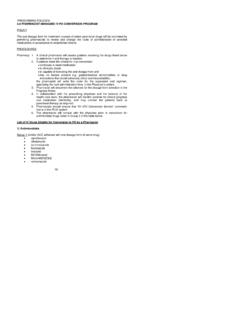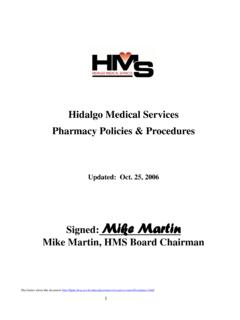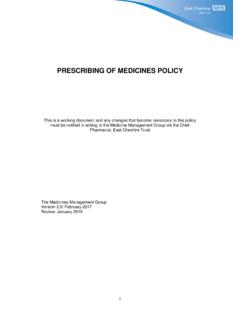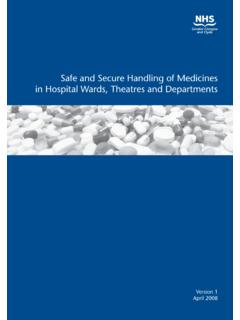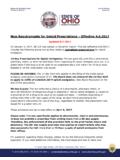Transcription of The community pharmacy - nhsemployers.org
1 The community pharmacy A guide for general practitioners and practice staff July 2013 2 Contents Section 1 About this guide 3 Section 2 Qualifying as a pharmacist 3 Education and training 4 Extending skills 4 Section 3 Key national bodies 5 Section 4 The NHS community pharmacy Contractual Framework 6 Section 5 Funding for community pharmacies 9 Funding for the national pharmacy contract 9 Medicines reimbursement 10 The impact of medicines reimbursement on CCG prescribing budgets 11 The impact of cost saving prescribing policies 11 Section 6 Running a community pharmacy 13 The role of the pharmacist 13 pharmacy support staff 14 Section 7 community pharmacies investing in the future 16 Section 8 Frequently asked questions 16 The community pharmacy A guide for general practitioners and practice staff 3 Section 1.
2 About this guide This guide aims to support general practitioners (GPs) and community pharmacists in developing more effective working relationships and in turn, improve primary care services for patients. It covers key areas such as funding arrangements for pharmacies, the impact of prescribing policies and the range of clinical and administrative functions that community pharmacies currently provide. This guide has been developed jointly by the NHS Employers organisation, the British Medical Association s General Practitioners Committee (GPC) and the Pharmaceutical Services Negotiating Committee (PSNC). A similar guide has been produced for pharmacists to give them an insight into the working life of a GP and their practice, and different contracting routes for GPs, including the General Medical Services (GMS) contract.
3 These guides aim to support the two professional groups, as well as provide an insight for commissioners as new ways of integrated working in primary care start to take shape. Section 2. Qualifying as a pharmacist As with other healthcare professions, the underlying principle for all pharmacy education and training is ensuring safe and effective care for patients. This principle underpins pharmacists work throughout their undergraduate, postgraduate and continued learning, and subsequent career pathway. The community pharmacy A guide for general practitioners and practice staff 4 Education and training Extending skills A growing number of pharmacists are undertaking prescribing qualifications to become both supplementary and independent prescribers.
4 Although the majority of pharmacist prescribers use their skills in secondary care, community pharmacists are also demonstrating their value in primary care, for example management of substance misuse. Some pharmacists have also taken the opportunity to develop skills in specialised areas and gain accreditation as a pharmacist with a special interest (PhwSI).Undergraduate degree course Four years covering: origin and chemistry of drugs preparation of medicines, including the formulation of drugs action and uses of drugs and medicines, including physiology, biochemistry, microbiology, pathology and pharmacology pharmacy practice. As a condition of General Pharmaceutical Council (GPhC) registration, all pharmacists are required to undertake and record continuing professional development activities to maintain and enhance their competence.
5 Many pharmacists voluntarily pursue further postgraduate academic degrees in such subjects as clinical pharmacy and evidence based pharmacotherapy. External professional examination Allows entry on to professional register. Postgraduate pre-registration One year covering: competency based knowledge and skills framework complex project communication skills development. The community pharmacy A guide for general practitioners and practice staff 5 Section 3. Key national bodies There are several national organisations that have key functions for community pharmacy . These include the General Pharmaceutical Council, the Royal Pharmaceutical Society and the Pharmaceutical Services Negotiating Committee. The General Pharmaceutical Council The General Pharmaceutical Council (GPhC) was formed in September 2010 as an independent body responsible for all aspects of professional regulation.
6 Previously all functions of the professional regulator were incorporated into the work of the Royal Pharmaceutical Society of Great Britain (RPSGB). The regulatory body sets and monitors the professional standards and principles that all pharmacists must work to, as well as setting the standards for undergraduate education and pharmacy premises. The core professional principles that underpin a pharmacist s work are set out in standards of conduct, ethics and performance that every pharmacist must comply with. Additionally, there are standards for registered pharmacies; continuing professional development; and initial education and training requirements for pharmacists and pharmacy technicians. The Royal Pharmaceutical Society The Royal Pharmaceutical Society (RPS), formerly the Royal Pharmaceutical Society of Great Britain, transferred its regulatory functions to the GPhC in September 2010, and now acts solely as the professional leadership body.
7 It offers support and advice to pharmacists to ensure they are up to date with current practices, as well as developing guidance documents to support high-quality and safe pharmacy practice. The Pharmaceutical Services Negotiating Committee The Pharmaceutical Services Negotiating Committee (PSNC) is the representative body for community pharmacies in England that provide NHS services. It negotiates the national NHS contractual terms on behalf of pharmacy contractors, and provides support to the network of local pharmaceutical committees (LPCs). The community pharmacy A guide for general practitioners and practice staff 6 Section 4. The NHS community pharmacy Contractual Framework (CPCF) A new contractual framework for community pharmacies was introduced in April 2005.
8 The table below lists the types of services included in the contractual framework. Essential services Provided by all contractors. This consists of the following core services: dispensing repeat dispensing disposal of unwanted medicines promotion of healthy lifestyles (public health) signposting support for self-care. Services are provided under a clinical governance framework that includes clinical audit and information governance requirements. Advanced services Can be provided by all contractors once accreditation requirements have been met. Currently there are four advanced services: 1. Medicines Use Review (MUR) and Prescription Intervention (PI) Service. Regular MURs can be prompted proactively by identification of a certain group of patients (for example those in the national target groups) that subsequently lead to an invitation for an MUR.
9 A prescription intervention MUR is more reactive, in the sense that it is the response to a significant adherence problem with a person's medication that subsequently leads to an MUR being conducted. The issue or issues that prompt the pharmacist to offer an MUR in this circumstance are likely to be highlighted as part of the dispensing process. Commonly the issues will highlight the need for the patient to develop their understanding of their medicines in order to improve their own use of the medicines. The same consultation occurs for MURs and PI MURs, for example establishing the patient s actual use, understanding and experience of taking all their medicines; identifying, discussing and assisting in the resolution of poor or ineffective use of drugs by the patient; identifying side-effects and drug interactions that may affect the patient s The community pharmacy A guide for general practitioners and practice staff 7 compliance with instructions given to him/her; and improving the clinical and cost effectiveness of drugs prescribed to patients, thereby reducing drug wastage.
10 In October 2011 a new requirement was introduced that at least 50 per cent of all MURs undertaken by each pharmacy must be for patients who fall within one or more of the national target groups. These groups are: patients taking a high-risk medicine (on a nationally agreed list) patients with respiratory disease patients recently discharged from hospital who have had changes made to their medicines whilst in hospital. MURs can still be carried out on patients who are not in one of the target groups if, in the pharmacist's professional opinion, the patient will benefit from the service. For more information about this service see Guidance on the Medicines Use Review service. 2. Stoma Appliance Customisation service 3. Appliance Use Review service.
